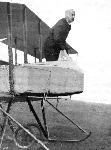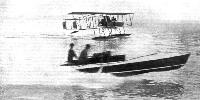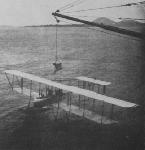R.Mikesh, A.Shorzoe Japanese Aircraft, 1910-1941 (Putnam)
Navy Type Mo Small Seaplane
The first two Maurice Farman Seaplanes were imported into Japan by the Navy and assembled at Oppama for initial flying demonstrations in October and November 1912. An additional two were purchased and used for flying training over a considerable period. The relatively simple construction was soon copied by the Yokosuka Naval Arsenal which added a small number to the four already imported. Being of the same type as that of the Army, they received the same short designation Type 10 Small Seaplane. These had fabric-covered wooden structures and were equipped with twin Tellier-type wooden floats. The two seats were in tandem in a fuselage pod, with a 70hp Renault pusher engine in the rear.
When the Tsingtao Campaign erupted in September 1914, three of the imported Type Mo Small Seaplanes, together with one imported Type Mo Large Seaplane, were carried by the seaplane tender Wakarniya to participate in the campaign. They were soon joined by a fourth aircraft which was a japanese-made Type Mo Small Seaplane of the same type. These aeroplanes, manned by seven pilots during this two-month operation, succeeded in making 49 sorties during which they dropped 199 bombs. Working with Army aircraft in these air operations, they were unsuccessful in attacks on their most important target, the cruiser Kaiserin Elisabeth, but did succeed in sinking one small torpedo-boat with bombing attacks.
Single-engine twin-float pusher biplane reconnaissance/bomber. Wooden structure with fabric covering. Crew of two in open cockpit.
70hp Renault eight-cylinder vee aircooled engine, driving a two-bladed wooden propeller.
Span 15.50m (58ft 10 1/4in); length 10.14m (33ft 3in); height 3.80m (12ft 5 1/2in); wing area 56sq m 602.798sq ft).
Empty weight 650kg (1,433Ib); loaded weight 855kg (1,884Ib).
Maximum speed 46kt (53mph) at sea level; climb to 500m (1,640ft) in 11min; service ceiling 1,500m (4,921ft); endurance 3hr.
Several built beginning in July 1913.
Navy Type Mo Large Seaplane (Maurice Farman 1914 Seaplane)
This was a large seaplane with a 100hp engine which the Navy imported from France in 1914. Designated Type Mo Large Seaplane, it was superior in general performance to the Type Mo Small Seaplane, particularly in its operational altitude of 3,000m (9,843ft). The aeroplane was larger than the 1912 model and could carry a crew of three.
Soon after its arrival from France the aeroplane was deployed aboard the seaplane tender Wakamiya in support of the Tsingtao Campaign in September 1914, along with the three Type Mo Small Seaplanes. They were used in this operation for reconnaissance, spotting of German mines, and bombing missions.
Production of the Type Mo Large Seaplane was undertaken by the Yokosuka Naval Arsenal with few changes. Most noteworthy was the change of engine to the 100hp Benz instead of the 100hp Renault installed in the imported example. Eventually these Type Mo Large Seaplanes were redesignated Ro-go Otsu-gata.
It was only natural to continually test the capabilities of these and other aircraft with long-distance and duration flights. On 4 March, 1915, Lieut Kishichi Umakoshi piloted one of the Ro-go Otsu-gata (serial No.2) for nearly eight hours over a closed course Oppama, Yokosuka, Yokohama, Bohsou coastline, Miura Peninsula, and back to Oppama. This endurance record was soon broken by a similar aircraft that recorded a duration of 10hr 5min, covering 434nm (500 sm), and, with another, an altitude of 3,500m (11,500ft) was recorded.
The first fatal accident involving japanese Naval aviators occurred with one of the Yokosho-made aircraft (serial No.15) when it crashed at sea on 6 March, 1915, with Sub-Lieuts Tozaburo Adachi and Takao Takerube along with W/O 3/c Hisanojo Yanase on board, killing all three.
Single-engine twin-float pusher biplane reconnaissance/bomber with enclosed crew nacelle. Wooden structure with fabric covering. Crew of three in open cockpit.
100hp Benz six-cylinder inline watercooled engine, driving a two-bladed wooden propeller.
Span 19.02m (62ft 5in); length 9.43m (30ft 11 1/4in); height 4m (13ft 1 1/2in); wing area 50sq m (538.213sq ft).
Empty weight 995kg (2,193Ib); loaded weight 1,363kg (3,004Ib).
Maximum speed 52kt (59.8mph) at sea level; climb to 1,000m (3,280ft) in 25min; endurance 4 1/2-6 1/2hr.
At least fifteen built.
 |
Журнал - Flight за 1913 г.
|
| The new Maurice Farman biplane without front elevator which arrived at Hendon Aerodrome last week.
|
 |
Журнал - Flight за 1913 г.
|
| The Marquis LarientyTholozan a nephew of the Marquis De Dion and a well-known aviator in France, was flying on Saturday last at the Hendon Aerodrome on his new Farman biplane fitted with a 120 h.p. 8-cyl. De Dion Bouton engine. Although the Marquis had never previously taken his seat in this machine, without a hitch, after the propeller had been given its usual spin, he was up in the air and made two circuits of the aerodrome.
|
 |
A.Imrie - German Bombers /Arms & Armour/
|
| Major Siegert, Kommandeur of the Fliegerstation at Metz, began night flying training for his pilots in February 1913. Although the practice was officially frowned upon, Siegert showed that the pilots lost any apprehension they might have had once they were introduced to night flying, and on 23 April he even held night manoeuvres when ten aircraft flew without incident, in co-operation with searchlights. In this early night flying scene at a military aerodrome an Aviatik biplane (whose rudder has suffered from retouching) is being put into the hangar. The aircraft in the foreground is a dual-control Otto-built Farman copy powered by a 100hp Argus engine.
|
 |
M.Goodall, A.Tagg - British Aircraft before the Great War /Schiffer/
|
| Airco. The MF 7bis seaplane version of the Longhorn had no front booms or foreplane.
|
 |
Журнал - Flight за 1914 г.
|
| The First Lord of the Admiralty in Navy Seaplane No. 95 in Portsmouth Harbour prior to his ascent last Monday.
|
 |
Журнал - Flight за 1913 г.
|
| WELL MATCHED. - A Maurice Farman avion versus motor boat.
|
 |
Журнал - Flight за 1913 г.
|
| A Maurice Farman Navyplane in the air.
|
 |
Журнал - Flight за 1914 г.
|
| IN THE SMOKE OF H.M.S. "PRINCE OF WALES." - The Navy seaplane, with the First Lord of the Admiralty - Mr. Winston Churchill - on board, following the "Prince of Wales" as she is passing out of Portsmouth Harbour.
|
 |
Jane's All The World Aircraft 1919 /Jane's/
|
| A Maurice Farman Seaplane coming alongside a Seaplane Carrier.
|
 |
R.Mikesh, A.Shorzoe - Japanese Aircraft, 1910-1941 /Putnam/
|
| Yokosho Navy Type Mo Small Seaplane.
|
 |
R.Mikesh, A.Shorzoe - Japanese Aircraft, 1910-1941 /Putnam/
|
| Yokosho Navy Type Mo Large Seaplane.
|
 |
Журнал - Flight за 1916 г.
|
| SEAPLANE AND SUBMARINE. - A study.
|
 |
O.Thetford - British Naval Aircraft since 1912 /Putnam/
|
| Farman Shorthorn
|














